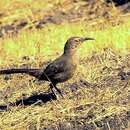zh-TW
在導航的名稱


The California thrasher (Toxostoma redivivum) is a large member of family Mimidae found primarily in chaparral habitat in California and Baja California. It is the only species of Toxostoma throughout most of its range.[2][3]
The California thrasher is closely related to the crissal thrasher (Toxostoma crissale) and LeConte's thrasher (T. lecontei), and the three may form a superspecies. It has two subspecies, the nominate T. r. redivivum and T. r. sonomae.[2][3]
The California thrasher is about 32 cm (13 in) long and weighs up to 90 g (3.2 oz); it is the largest thrasher. It has a distinctive long, decurved beak and a long tail. It is generally deep grayish brown above with olive tones on the tail. It has a grayish buff supercilium, a dark cheek pattern and eye line, and unlike most thrashers, has dark eyes. The underparts are mostly buffy to tawny brown, with the upper breast and flanks a smoky gray. The two subspecies differ only slightly.[3]
The nominate subspecies of California thrasher is found from Santa Cruz and Placer counties, California, south into northwestern Baja California, Mexico. T. r. sonomae is found from Trinity and adjoining counties in northern California southwards to the range of the nominate subspecies. There appears to be slight overlap allowing gene flow between them.[3]
The California thrasher is a year round resident of both slopes of the California Coast Ranges and the western slope of the Sierra Nevada. It is only rarely found in the Central Valley between them. Its primary habitat is chaparral. It also inhabits sagebrush, juniper bushland, and riparian and oak woodlands with a dense understory. It is sometimes found in suburban parks and yards that have dense cover. In elevation it ranges generally as high as 1,600 m (5,200 ft) and as high as 2,000 m (6,600 ft) in southern California mountains.[3]
This species' behavior is difficult to observe because it tends to keep hidden in dense cover. In the open it runs swiftly with its tail raised.[3]
The California thrasher forages mostly on the ground, by digging and sweeping leaf litter and soil with its bill. It walks or hops between foraging stops. Its diet in spring is almost exclusively insects and other small invertebrates, to which it adds small soft fruits during the rest of the year. When feeding on fruits it can be in exposed situations, but is often under cover.[4][3]
The California thrasher's core breeding season spans from February into July, though it often begins in January. It often raises two broods. Both sexes build the nest, an open cup of fine twigs and roots lined with finer material such as strips of bark and dried forbs, and placed on a platform of larger twigs. The nest is usually hidden in dense shrubs, typically between 1 and 3 m (3.3 and 9.8 ft) above ground. The clutch size is usually three to four. Both parents incubate the eggs and brood and feed the young. Common raven (Corvus corax) and California scrub jay (Aphelocoma californica) are common predators of eggs and nestlings.[3]
The California thrasher is a "striking and exuberant songster". It mimics many of the species that share its habitat, and both sexes sing. It typically sings from elevated and exposed perches, "vigorous and 'cheerful' phrases variously repeated". It also has a wide variety of calls.[3]
The IUCN has assessed the California thrasher as being of Least Concern. It has a very large range, and very large population that has shown only a small decrease in recent decades. Habitat fragmentation and conversion appear to be the largest threats.[1][3]
The California thrasher (Toxostoma redivivum) is a large member of family Mimidae found primarily in chaparral habitat in California and Baja California. It is the only species of Toxostoma throughout most of its range.